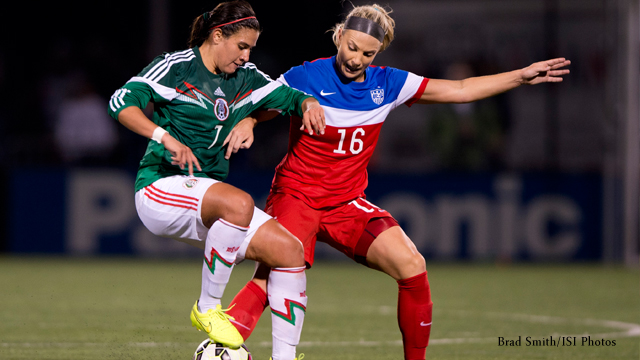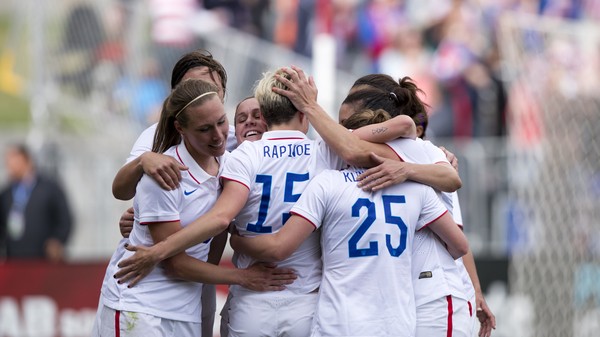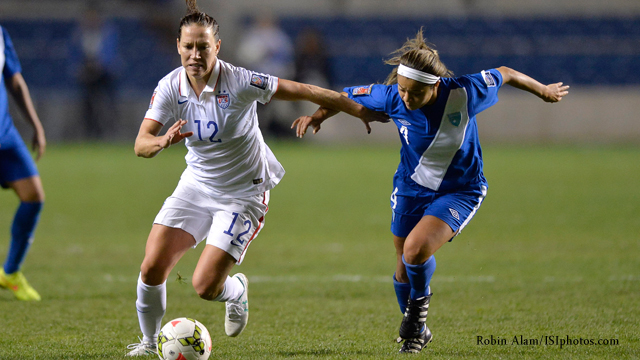Four thoughts on the Women’s World Cup Draw (and FIFA)

So that could have gone better for the U.S. Women’s National Team. The draw for the 2015 Women’s World Cup has placed the USWNT into Group D, along with Sweden, Nigeria, and Australia—likely the toughest possible set of group-stage opponents.
The US will play Australia on June 8 in Winnipeg, will remain in Winnipeg to play Sweden on June 12, and will finish the group stage against Nigeria on June 16 in Vancouver.
+READ: USWNT to face Australia, Sweden, Nigeria in Group D at 2015 World Cup
The top two teams from each group, along with the top four third-place finishers, will advance to the round of 16. (For details on the fifteen possible ways to assign the third-place finishers to places in the knockout stage bracket, see page 40 of FIFA’s published rules for this World Cup.)
Here are four thoughts on the implications of the draw for the U.S., and one on what it says about FIFA.
Group D is for Difficult, Not Death
For all the immediate comparisons with the MNT in Brazil this year, it’s a little hard to call Group D a “group of death” when 3 out of its 4 teams have a legitimate chance to advance. At a minimum, with all due respect to the Matildas, the USWNT—still for the moment first in FIFA’s world rankings—should be able to finish ahead of Australia. And while making it into the round of 16 via a third-place finish would be terribly embarrassing, so was having to qualify for the 2011 World Cup through a playoff. It still counts.
 That said, Group D is easily the strongest in the tournament—and miles more difficult than Groups B and C, in which Germany and Japan each face a pair of World Cup debutants (Cote d’Ivoire and Thailand, and Switzerland and Cameroon, respectively). The group matches will be a serious challenge, albeit one that the supposed No. 1 team in the world ought to be able to handle.
That said, Group D is easily the strongest in the tournament—and miles more difficult than Groups B and C, in which Germany and Japan each face a pair of World Cup debutants (Cote d’Ivoire and Thailand, and Switzerland and Cameroon, respectively). The group matches will be a serious challenge, albeit one that the supposed No. 1 team in the world ought to be able to handle.
But…it’s a brutal bracket. If (when) the U.S. gets out of the group, its likely paths through the knockout rounds are, if anything, worse. Winning the group stage, for example, might well pit us against France or Germany, or later, Japan, in the knockout rounds; and one of the two possible third-place scenarios would likely pit us against Germany as early as the round of 16.
+READ: Women’s World Cup TurfGate: An expert legal analysis of the players’ strategy
Obviously, if the U.S. want to win their first World Cup in 15 years, they will have to face top opposition — including the teams that are their peers (or superiors) at the highest levels of the women’s game. But the bracket that FIFA set up (on which more below) did the USWNT no favors.
Is the U.S. Up to the Job?
Never mind the knockout rounds, how well will the U.S. handle the challenge in the group stage? There is room for doubt. At a minimum, Sweden, Nigeria, and Australia are all quality opponents. (Sweden, in fact, should have been seeded over Brazil.) And while the U.S. may have its much-vaunted winning mentality, that has not exactly translated into playing scintillating matches since Jill Ellis took over in April. Most recently, the U.S. performance in World Cup qualifying, against weaker opposition, would best be described as labored.

For all the talk about a fluid possession style, the U.S. attack under Ellis has seemed unstructured and overly reliant on getting the ball wide to cross into an overcrowded penalty area, for all the world like teams in 1980s England.
True, the other teams in Group D are, like the U.S., better known for direct, physical play rather than finesse. But that merely foregrounds the additional issue of whether Ellis’s evident plan to play Lauren Holiday out of position as a holding midfielder will yield sufficient defensive solidity, particularly in transition. Should the U.S. advance to play the other top teams in the world — teams that are known for their tactical sophistication — these questions will only become more urgent.
+READ: USWNT analysis: Will a real No. 6 please stand up?
Thus far, moreover, Ellis has answered such questions by alluding to the short time she has been in charge, and suggesting that her players have lacked enough playing time with one another. Considering Ellis’s deep history with the WNT over the last decade, the settled nature of the U.S. squad over the last several years, and the number of friendlies the U.S. plays each year, these excuses ring somewhat hollow.
Will Ellis be able to devise and instill a better style and structure in the next six months that will allow the U.S. to match up evenly with France, Germany, and Japan? That remains very much to be seen.
Do We Know the 23 (and the 11)?
One of the criticisms of the USWNT under Ellis has been that she is overly reliant on what she describes as a “consistent core group” of (entrenched, aging) players. And while Ellis has talked about the depth of the U.S. player pool and bringing young players into the squad, it was striking that during World Cup Qualifiers, one of those young players, Julie Johnston (pictured at top), received no playing time at all.
The U.S. are holding a training camp in January, which Ellis told reporters would be combined with a camp for players who had strong seasons in the NWSL this year and standouts on the U-23 national team.
One wonders whether this will actually result in a broader set of players having a shot at the final squad of 23, or whether the squad was basically set even before Qualifiers began.
It will also be interesting to see during the World Cup itself how much Ellis rotates her squad. Several of Ellis’s preferred outfield starters (Christie Rampone, Carli Lloyd, Abby Wambach) are well over 30.
+READ: USWNT Lost & Found: Lori Chalupny returns, five years later
Some rotation will obviously be required by the physical challenges posed by facing three quality opponents in quick succession on turf. But how much? In other recent international tournaments — the U-20 Women’s World Cup this past summer, for example — U.S. women’s national teams have not used their full squads. Will things be different in Canada?
Would FIFA Treat the Men’s World Cup This Way?
FIFA waited until the day of the draw to disclose that its description of how the seeded teams would be allocated to groups was a sham — that FIFA would be assigning the teams to groups before the draw ever took place.
Doing it this way maximized the chances of FIFA obtaining its preferred matches between top opposition in the knockout rounds, such as a likely France-Germany quarterfinal meeting. Technically, this was not against FIFA’s published rules for the World Cup — which blandly state at page 31 that the groups shall be set by “seeding and drawing lots whilst taking sporting and geographic factors into consideration, as far as possible.”
But this is not how these tournaments are supposed to work. As for whether FIFA would use this approach for the draw of a Men’s World Cup? Well, of course not.












